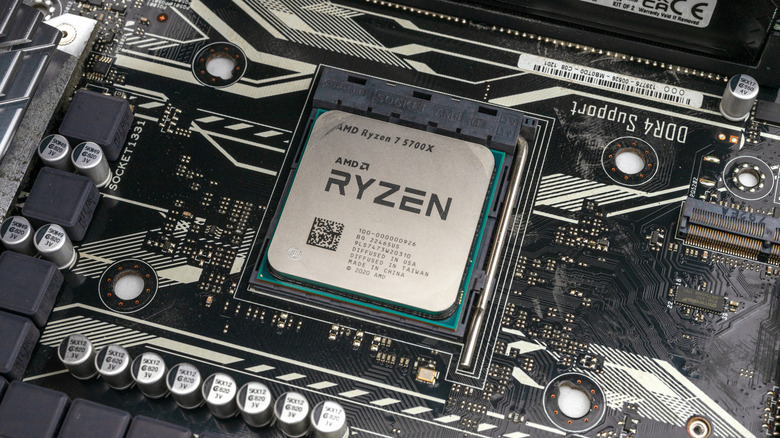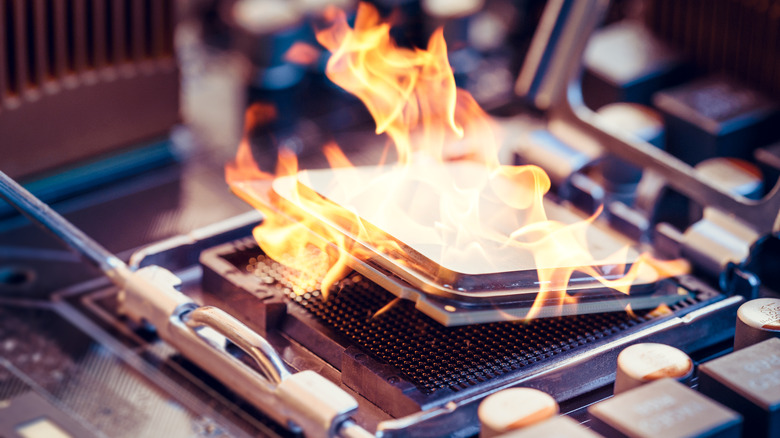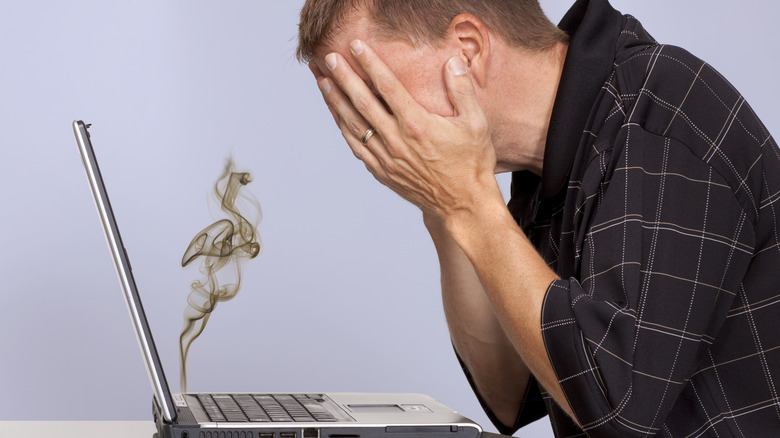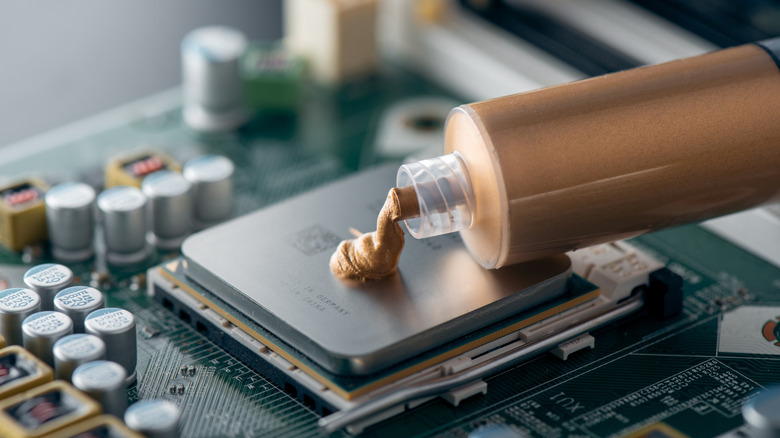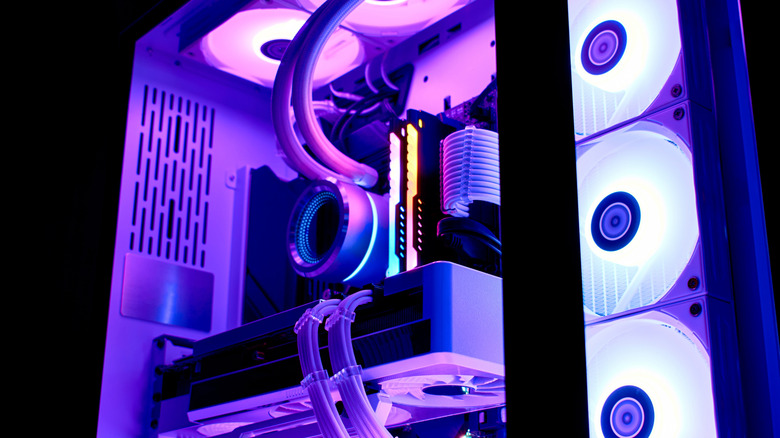How To Check CPU Temperature And Fix Overheating Problems
Whether you’re using a laptop or a desktop, CPU cooling may often be a bit of an afterthought. In truth, it’s something many people don’t have to think about unless they build their own PCs, and even if they do, cooling is something novice builders can overlook. However, as your processor is the heart of your whole computer, it’s important to give it the breathing space it needs to perform as well as it possibly can. But how do you find out your CPU temperature, and how do you know when it’s too high?
The tricky part of it all is that there are no one-size-fits-all guidelines for CPU temperatures. Some processors tend to run a bit hotter but still thrive under the pressure, and others struggle in the slightest bit of heat. Issues with CPU temperatures are more often attributed to desktop computers rather than laptops, but neither is immune to these problems. The components in laptops are tightly packed, which means they’re pretty susceptible to general overheating, CPU or otherwise. One thing is for sure: PCs, in general, do not like heat.
The consequences of an overheating CPU can range from mild annoyances to massive computer breakdowns. To avoid the latter, your best bet is to nip overheating in the bud, and we’re here to help. Read on to diagnose high CPU temperatures and find out how to fix them.
CPU overheating: Warning signs
Having dealt with CPU overheating in the past, I’ve experienced the full range of warning signs that you get when your computer is struggling with temperatures. As the CPU impacts every part of your PC’s performance, it’s very visible that something is wrong—but it’s not always easy to tell that the CPU is the culprit. Keep an eye out for the following:
Reduced performance. While your PC might feel slow for any number of reasons, it’ll always be slow if it’s dealing with heat. This includes stuttering, freezes, and slow loading times.
Issues in games. If you’re a gamer, you’ll notice things such as frame rate drops or lower FPS (frames per second). These are a tell-tale sign that your PC is struggling.
System shutdowns. When your CPU is overheating, the PC may often shut down automatically to prevent further hardware damage. Therefore, you’ll start seeing random shutdowns and restarts.
Blue Screen of Death (BSOD). This is like a PC crash with extra steps, and you’ll often get a thermal-related error message while your CPU tries to stay cool.
Noisy fans. Depending on your cooling setup, this might be the norm, but if things are getting louder, it means that your fans are working overtime to keep your PC running.
More often than not, it’s not just your CPU that’s having a bad time — the rest of the PC is overheating, too. If you use a discrete graphics card, that’s another culprit that’s likely to struggle with heat. As a result, artifacts, glitches, and crashes can mean that your GPU or motherboard is overheating.
How to check CPU temperatures
There are a few ways to check CPU temperatures, and while it’s possible to do it without downloading third-party software, it’s a lot easier if you do. But, there’s a catch. There are two CPU temps to be checked: At idle and under load. “Idle” refers to your processor’s temperature when you’re not really using your PC for anything and you don’t have anything running in the background. Active temperatures are more often the problem, and those can be checked if you’re running a game or some other resource-heavy software. We recommend checking both.
You can check your CPU temps via the BIOS/UEFI. This tells you idle temperatures and can be done on any PC or laptop. To do it, restart your computer and press the designated key (usually F12 or DEL, but it varies based on manufacturer). Then, look for sections like “Hardware Monitor,” “System Health,” or “CPU Settings.”
Moving on to third-party software, a popular option is Core Temp. This is a quick and easy tool that monitors your CPU temperature in real-time, which means you can use it during gaming to see the temps under load. Some of my favorite alternatives to Core Temp include HWiNFO and NZXT CAM. Both have user-friendly interfaces and are easy to navigate; moreover, they can also tell you your GPU temperatures. To get a solid result, check several times when idle and then under load, then take note of each result. Your next step is to figure out whether these temperatures are too high or not.
Is your CPU temperature too high?
Just a decade ago, a CPU temperature reaching 80 degrees Celsius (176 Fahrenheit) would’ve been disastrous. These days, our PCs and laptops consume much more power and run a lot hotter, so as a result, even a seemingly high number doesn’t necessarily mean trouble. CPUs are now designed to skirt their thermal maximums and still perform well; it’s only a problem once you get past a certain threshold, and that threshold is set high if you’re using one of the best processors available. With that said it’s always good to be proactive about this type of thing and keep an eye out, as even slightly elevated temps can add up to more wear and tear over time.
Time for some bad news: It’s impossible to list the maximum temperature for every CPU, as they all have different recommended temps. A general ballpark figure for modern CPUs is at around 85 to 95 degrees Celsius, but this doesn’t apply to every model. Fortunately, regardless of whether you have AMD or Intel, you can check the maximum temps on each manufacturer’s website.
You’ll just need to know which exact model of CPU you own. To do that in Windows, either right-click the taskbar or press Ctrl + Alt + Del at the same time, then select Task Manager. Switch to the Performance tab and click on CPU on the left side, then check the upper right corner. Look up your CPU for manufacturer guidance on temperatures. If your CPU is consistently running too hot, it’s time to try out some fixes to give it some much-needed relief.
Give your PC a good clean (and replace thermal paste)
You’d be surprised how big a difference cleaning your PC can make. Over time, dust can accumulate inside your PC, and if you’ve got it down on the floor, you’ll likely find some debris or pet hair (shoutout to my dog for shedding all over the place). Needless to say, your PC doesn’t love that, so it’s best to get it all out and let the fans work at full capacity. Replacing thermal paste is also important. This is a substance you apply between the CPU and the cooler to boost heat transfer. Unfortunately, it can dry out over the years, drastically reducing its efficiency. To clean a desktop PC, do the following:
Shut down your PC and unplug everything.
Ground yourself, either with an anti-static wrist strap or by touching an unpainted metal surface.
Open the case.
Grab a can of compressed air and blow out dust from the fans, heatsinks, vents, and other components. Make sure to hold it upright, and only use short bursts of air, and don’t spin the fans too quickly.
If you know your way around building a PC, you can remove all the components and clean them separately.
Use a soft brush or a soft, lint-free cloth to remove stubborn dust from fan blades.
Wipe down larger surfaces inside the case.
Apply new thermal paste—we have a separate guide full of thermal paste tips.
Reassemble the PC, turn it back on, and test your temps again.
The cleaning process for laptop users is obviously very different, so if you’re willing to give it a try, check out the things you need to know before cleaning a laptop and read more about fixing laptop overheating issues.
Buy a better cooler
If cleaning your PC out didn’t help, your next step is to try to invest in a better cooler. Many desktops come with stock CPU coolers, which are fine for budget processors but may struggle under load. Even if your computer didn’t come with a stock cooler, prebuilts often feature cheaper coolers that may be inadequate. In a desktop, your cooling options include air coolers, which use a heatsink and a fan to draw heat away from the CPU, and liquid coolers (also known as all-in-one or AIO) coolers. AIO coolers use liquid to transfer heat from your CPU to a radiator, where the fans take care of it.
Air coolers are much cheaper and easier to manage, but liquid coolers are much more effective. The general rule of thumb is that enthusiast-grade CPUs benefit from liquid coolers. For instance, the Ryzen 9800X3D can heat up a bunch, which is why AIO is the best option for that particular chip. However, if you have a budget or midrange chip, you’re fine with a stock cooler. If you’re not sure, we recommend looking it up on the manufacturer’s website or even simply using Reddit to ask other enthusiasts.
We have a separate guide to help you choose the best liquid cooler for your PC. With laptops, it’s a different story. You have no say in what cooler your laptop comes with, but you can always buy a cooling pad that can help.
Source: http://www.slashgear.com/1764721/how-to-check-cpu-temperature-fix-overheating-problems/
 techandtab
techandtab